seats GMC SAVANA 2006 Owner's Manual
[x] Cancel search | Manufacturer: GMC, Model Year: 2006, Model line: SAVANA, Model: GMC SAVANA 2006Pages: 394, PDF Size: 2.56 MB
Page 1 of 394
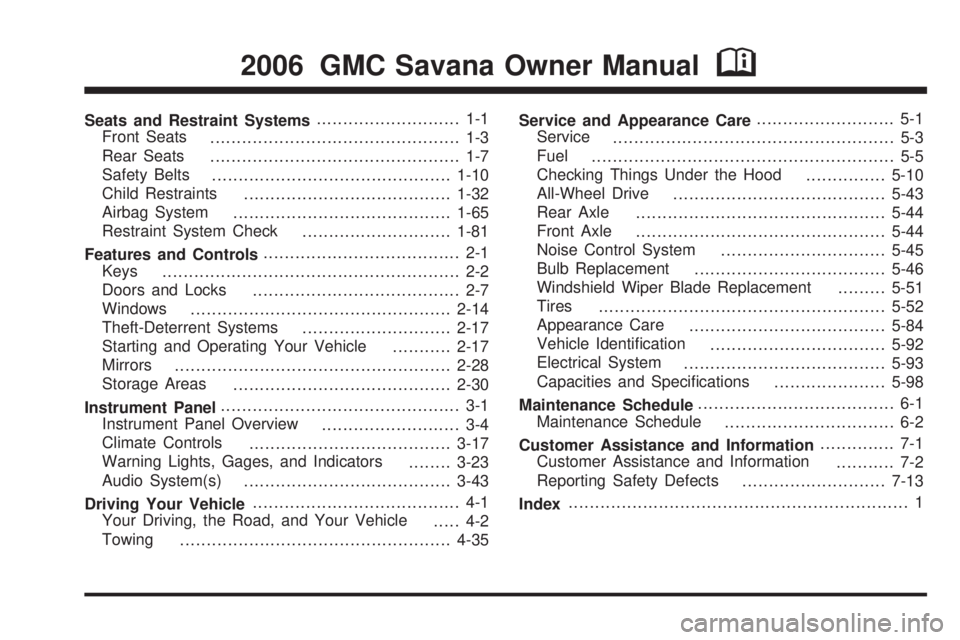
Seats and Restraint Systems........................... 1-1
Front Seats
............................................... 1-3
Rear Seats
............................................... 1-7
Safety Belts
.............................................1-10
Child Restraints
.......................................1-32
Airbag System
.........................................1-65
Restraint System Check
............................1-81
Features and Controls..................................... 2-1
Keys
........................................................ 2-2
Doors and Locks
....................................... 2-7
Windows
.................................................2-14
Theft-Deterrent Systems
............................2-17
Starting and Operating Your Vehicle
...........2-17
Mirrors
....................................................2-28
Storage Areas
.........................................2-30
Instrument Panel............................................. 3-1
Instrument Panel Overview
.......................... 3-4
Climate Controls
......................................3-17
Warning Lights, Gages, and Indicators
........3-23
Audio System(s)
.......................................3-43
Driving Your Vehicle....................................... 4-1
Your Driving, the Road, and Your Vehicle
..... 4-2
Towing
...................................................4-35Service and Appearance Care.......................... 5-1
Service
..................................................... 5-3
Fuel
......................................................... 5-5
Checking Things Under the Hood
...............5-10
All-Wheel Drive
........................................5-43
Rear Axle
...............................................5-44
Front Axle
...............................................5-44
Noise Control System
...............................5-45
Bulb Replacement
....................................5-46
Windshield Wiper Blade Replacement
.........5-51
Tires
......................................................5-52
Appearance Care
.....................................5-84
Vehicle Identification
.................................5-92
Electrical System
......................................5-93
Capacities and Specifications
.....................5-98
Maintenance Schedule..................................... 6-1
Maintenance Schedule
................................ 6-2
Customer Assistance and Information.............. 7-1
Customer Assistance and Information
........... 7-2
Reporting Safety Defects
...........................7-13
Index................................................................ 1
2006 GMC Savana Owner ManualM
Page 4 of 394
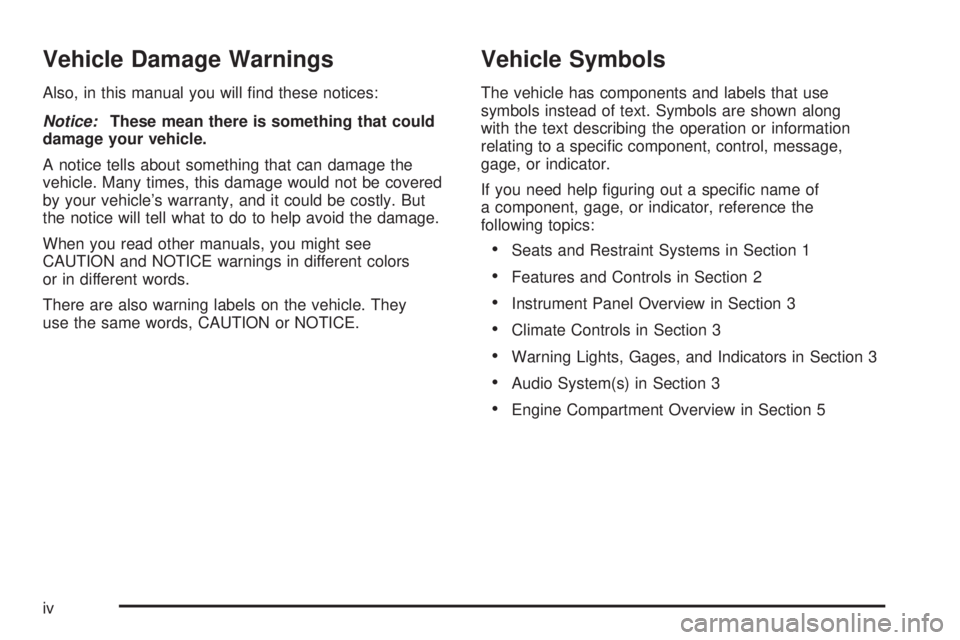
Vehicle Damage Warnings
Also, in this manual you will find these notices:
Notice:These mean there is something that could
damage your vehicle.
A notice tells about something that can damage the
vehicle. Many times, this damage would not be covered
by your vehicle’s warranty, and it could be costly. But
the notice will tell what to do to help avoid the damage.
When you read other manuals, you might see
CAUTION and NOTICE warnings in different colors
or in different words.
There are also warning labels on the vehicle. They
use the same words, CAUTION or NOTICE.
Vehicle Symbols
The vehicle has components and labels that use
symbols instead of text. Symbols are shown along
with the text describing the operation or information
relating to a specific component, control, message,
gage, or indicator.
If you need help figuring out a specific name of
a component, gage, or indicator, reference the
following topics:
•Seats and Restraint Systems in Section 1
•Features and Controls in Section 2
•Instrument Panel Overview in Section 3
•Climate Controls in Section 3
•Warning Lights, Gages, and Indicators in Section 3
•Audio System(s) in Section 3
•Engine Compartment Overview in Section 5
iv
Page 7 of 394
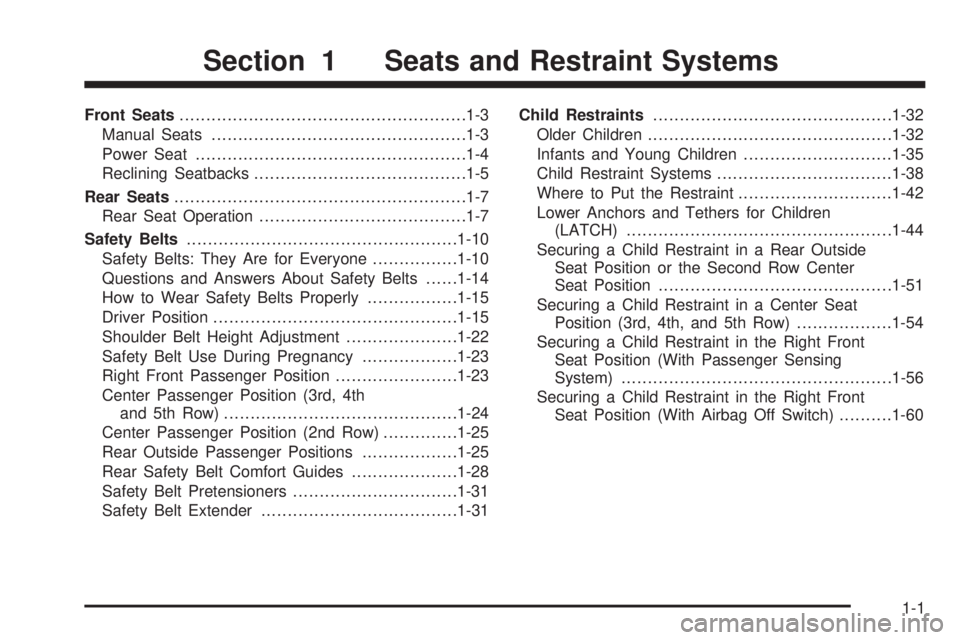
Front Seats......................................................1-3
Manual Seats................................................1-3
Power Seat...................................................1-4
Reclining Seatbacks........................................1-5
Rear Seats.......................................................1-7
Rear Seat Operation.......................................1-7
Safety Belts...................................................1-10
Safety Belts: They Are for Everyone................1-10
Questions and Answers About Safety Belts......1-14
How to Wear Safety Belts Properly.................1-15
Driver Position..............................................1-15
Shoulder Belt Height Adjustment.....................1-22
Safety Belt Use During Pregnancy..................1-23
Right Front Passenger Position.......................1-23
Center Passenger Position (3rd, 4th
and 5th Row)............................................1-24
Center Passenger Position (2nd Row)..............1-25
Rear Outside Passenger Positions..................1-25
Rear Safety Belt Comfort Guides....................1-28
Safety Belt Pretensioners...............................1-31
Safety Belt Extender.....................................1-31Child Restraints.............................................1-32
Older Children..............................................1-32
Infants and Young Children............................1-35
Child Restraint Systems.................................1-38
Where to Put the Restraint.............................1-42
Lower Anchors and Tethers for Children
(LATCH)..................................................1-44
Securing a Child Restraint in a Rear Outside
Seat Position or the Second Row Center
Seat Position............................................1-51
Securing a Child Restraint in a Center Seat
Position (3rd, 4th, and 5th Row)..................1-54
Securing a Child Restraint in the Right Front
Seat Position (With Passenger Sensing
System)...................................................1-56
Securing a Child Restraint in the Right Front
Seat Position (With Airbag Off Switch)..........1-60
Section 1 Seats and Restraint Systems
1-1
Page 8 of 394
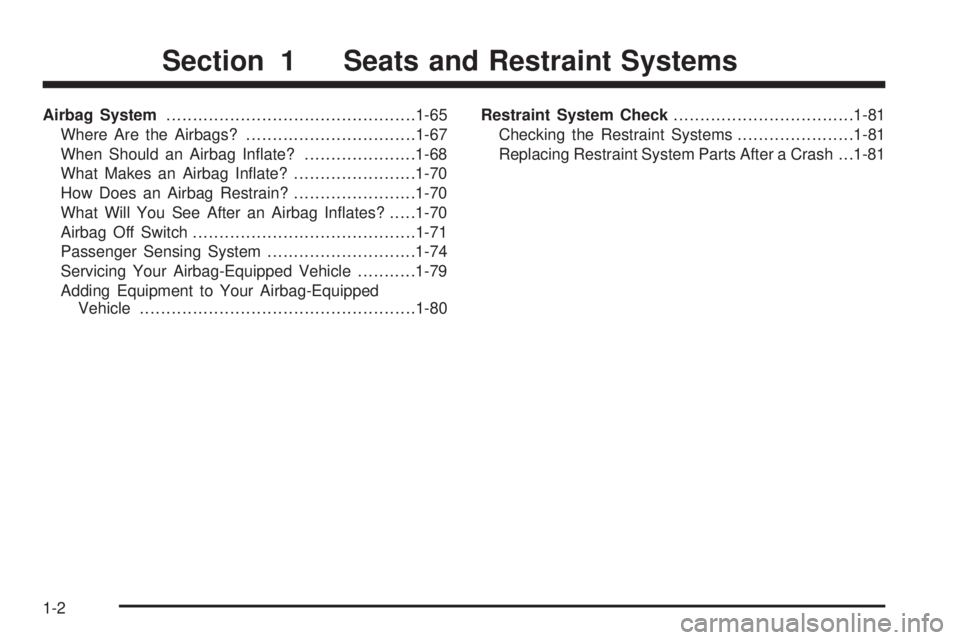
Airbag System...............................................1-65
Where Are the Airbags?................................1-67
When Should an Airbag Inflate?.....................1-68
What Makes an Airbag Inflate?.......................1-70
How Does an Airbag Restrain?.......................1-70
What Will You See After an Airbag Inflates?.....1-70
Airbag Off Switch..........................................1-71
Passenger Sensing System............................1-74
Servicing Your Airbag-Equipped Vehicle...........1-79
Adding Equipment to Your Airbag-Equipped
Vehicle....................................................1-80Restraint System Check..................................1-81
Checking the Restraint Systems......................1-81
Replacing Restraint System Parts After a Crash . . .1-81
Section 1 Seats and Restraint Systems
1-2
Page 9 of 394
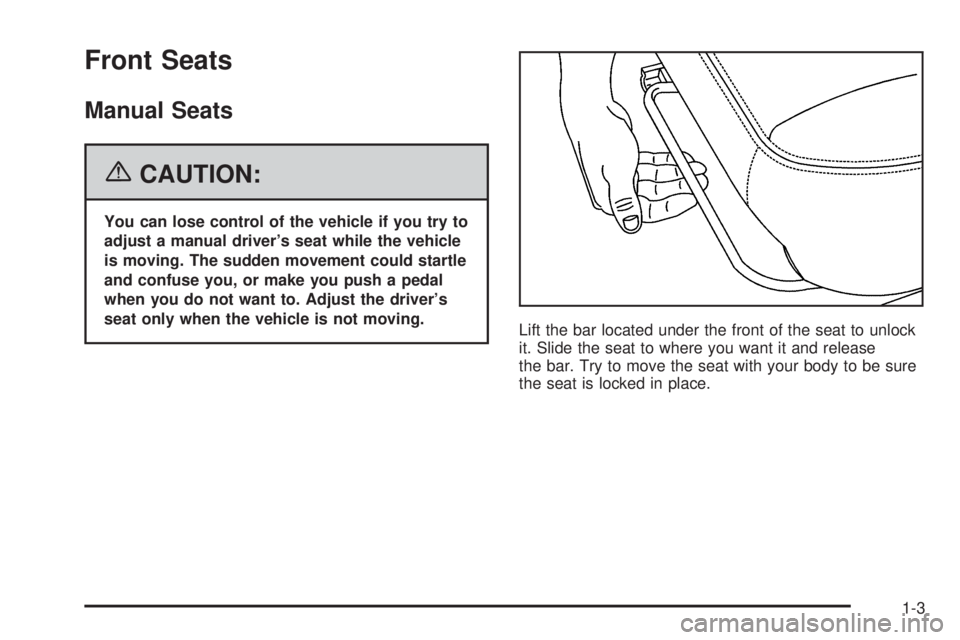
Front Seats
Manual Seats
{CAUTION:
You can lose control of the vehicle if you try to
adjust a manual driver’s seat while the vehicle
is moving. The sudden movement could startle
and confuse you, or make you push a pedal
when you do not want to. Adjust the driver’s
seat only when the vehicle is not moving.
Lift the bar located under the front of the seat to unlock
it. Slide the seat to where you want it and release
the bar. Try to move the seat with your body to be sure
the seat is locked in place.
1-3
Page 13 of 394
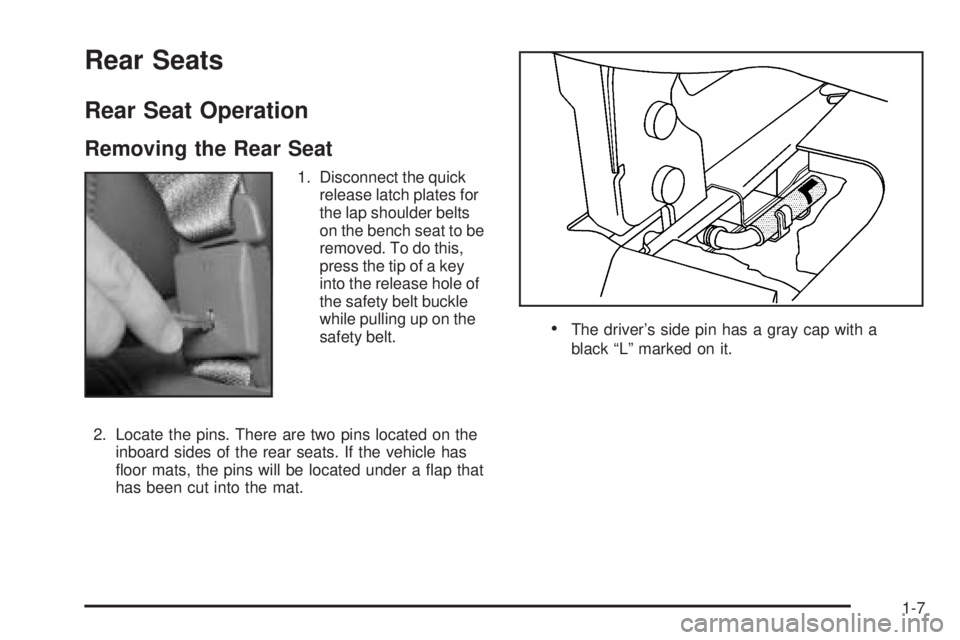
Rear Seats
Rear Seat Operation
Removing the Rear Seat
1. Disconnect the quick
release latch plates for
the lap shoulder belts
on the bench seat to be
removed. To do this,
press the tip of a key
into the release hole of
the safety belt buckle
while pulling up on the
safety belt.
2. Locate the pins. There are two pins located on the
inboard sides of the rear seats. If the vehicle has
floor mats, the pins will be located under a flap that
has been cut into the mat.
•The driver’s side pin has a gray cap with a
black “L” marked on it.
1-7
Page 14 of 394
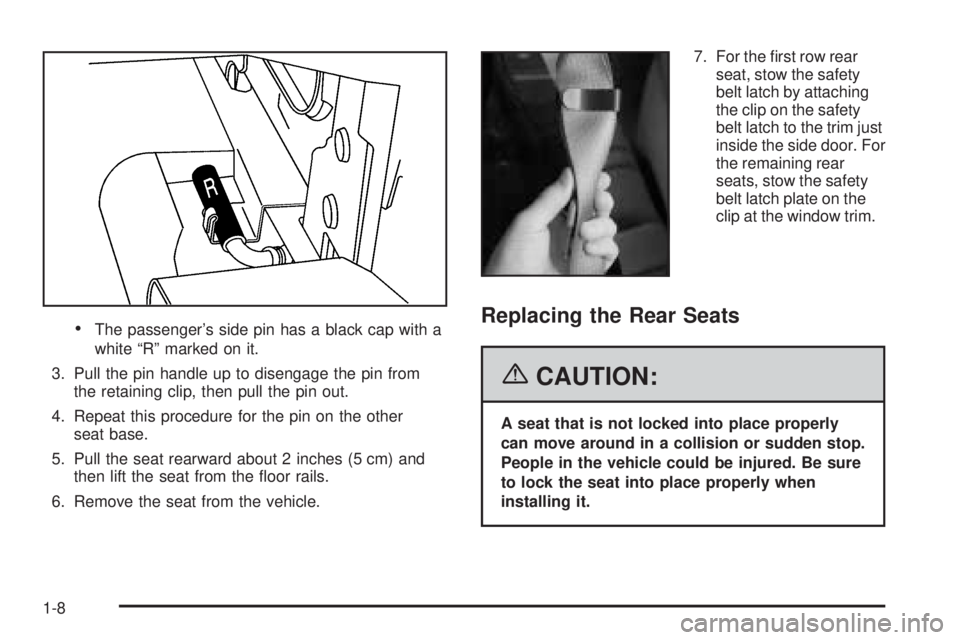
•The passenger’s side pin has a black cap with a
white “R” marked on it.
3. Pull the pin handle up to disengage the pin from
the retaining clip, then pull the pin out.
4. Repeat this procedure for the pin on the other
seat base.
5. Pull the seat rearward about 2 inches (5 cm) and
then lift the seat from the floor rails.
6. Remove the seat from the vehicle.7. For the first row rear
seat, stow the safety
belt latch by attaching
the clip on the safety
belt latch to the trim just
inside the side door. For
the remaining rear
seats, stow the safety
belt latch plate on the
clip at the window trim.Replacing the Rear Seats
{CAUTION:
A seat that is not locked into place properly
can move around in a collision or sudden stop.
People in the vehicle could be injured. Be sure
to lock the seat into place properly when
installing it.
1-8
Page 17 of 394
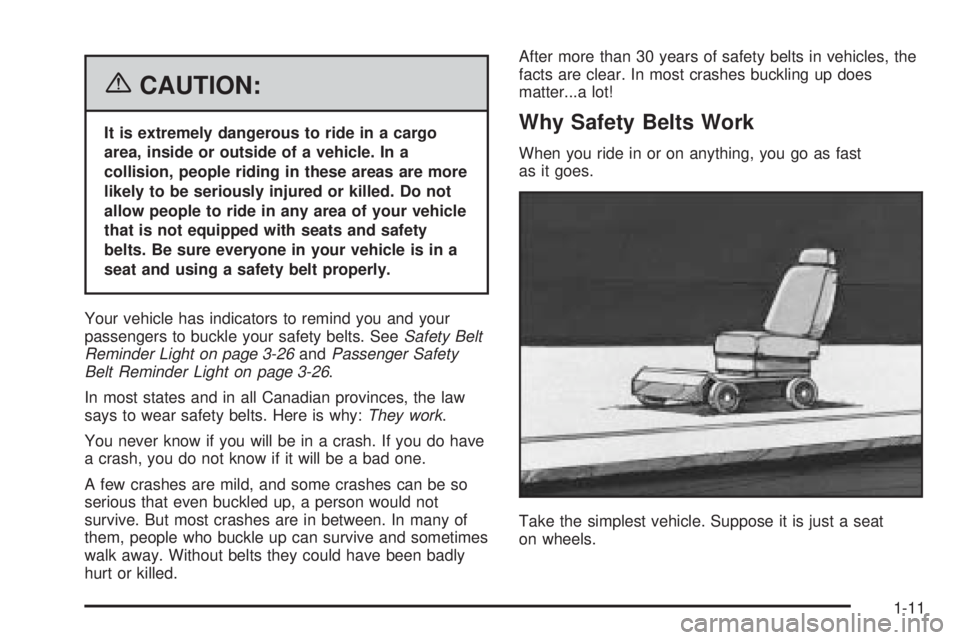
{CAUTION:
It is extremely dangerous to ride in a cargo
area, inside or outside of a vehicle. In a
collision, people riding in these areas are more
likely to be seriously injured or killed. Do not
allow people to ride in any area of your vehicle
that is not equipped with seats and safety
belts. Be sure everyone in your vehicle is in a
seat and using a safety belt properly.
Your vehicle has indicators to remind you and your
passengers to buckle your safety belts. SeeSafety Belt
Reminder Light on page 3-26andPassenger Safety
Belt Reminder Light on page 3-26.
In most states and in all Canadian provinces, the law
says to wear safety belts. Here is why:They work.
You never know if you will be in a crash. If you do have
a crash, you do not know if it will be a bad one.
A few crashes are mild, and some crashes can be so
serious that even buckled up, a person would not
survive. But most crashes are in between. In many of
them, people who buckle up can survive and sometimes
walk away. Without belts they could have been badly
hurt or killed.After more than 30 years of safety belts in vehicles, the
facts are clear. In most crashes buckling up does
matter...a lot!Why Safety Belts Work
When you ride in or on anything, you go as fast
as it goes.
Take the simplest vehicle. Suppose it is just a seat
on wheels.
1-11
Page 21 of 394
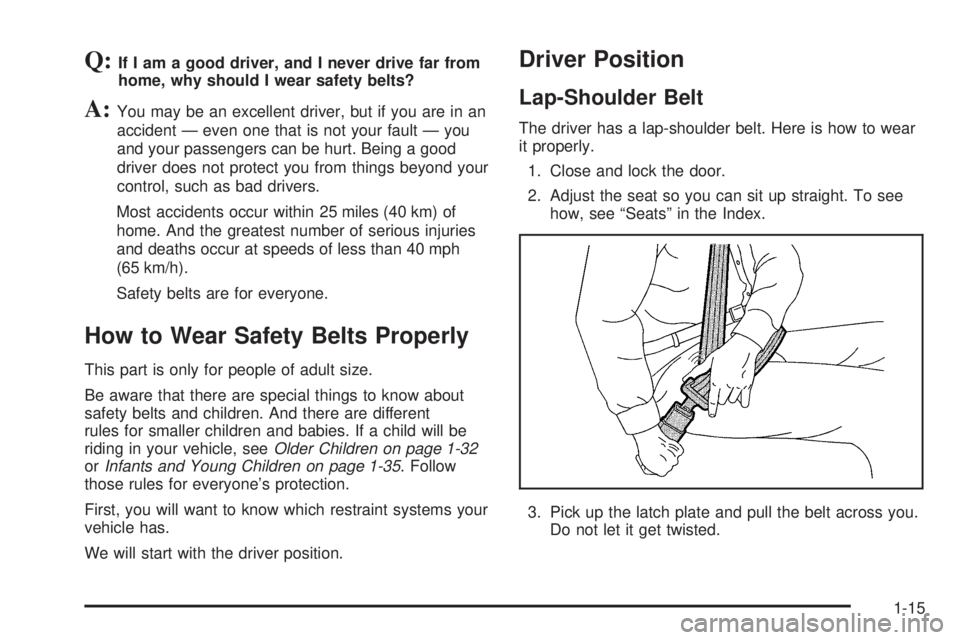
Q:If I am a good driver, and I never drive far from
home, why should I wear safety belts?
A:You may be an excellent driver, but if you are in an
accident — even one that is not your fault — you
and your passengers can be hurt. Being a good
driver does not protect you from things beyond your
control, such as bad drivers.
Most accidents occur within 25 miles (40 km) of
home. And the greatest number of serious injuries
and deaths occur at speeds of less than 40 mph
(65 km/h).
Safety belts are for everyone.
How to Wear Safety Belts Properly
This part is only for people of adult size.
Be aware that there are special things to know about
safety belts and children. And there are different
rules for smaller children and babies. If a child will be
riding in your vehicle, seeOlder Children on page 1-32
orInfants and Young Children on page 1-35. Follow
those rules for everyone’s protection.
First, you will want to know which restraint systems your
vehicle has.
We will start with the driver position.
Driver Position
Lap-Shoulder Belt
The driver has a lap-shoulder belt. Here is how to wear
it properly.
1. Close and lock the door.
2. Adjust the seat so you can sit up straight. To see
how, see “Seats” in the Index.
3. Pick up the latch plate and pull the belt across you.
Do not let it get twisted.
1-15
Page 30 of 394
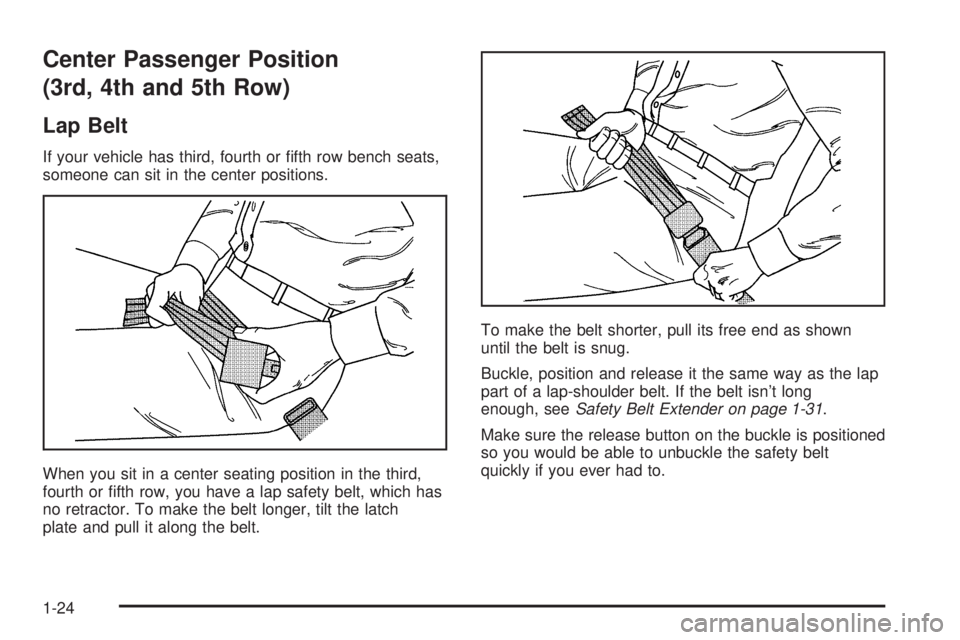
Center Passenger Position
(3rd, 4th and 5th Row)
Lap Belt
If your vehicle has third, fourth or fifth row bench seats,
someone can sit in the center positions.
When you sit in a center seating position in the third,
fourth or fifth row, you have a lap safety belt, which has
no retractor. To make the belt longer, tilt the latch
plate and pull it along the belt.To make the belt shorter, pull its free end as shown
until the belt is snug.
Buckle, position and release it the same way as the lap
part of a lap-shoulder belt. If the belt isn’t long
enough, seeSafety Belt Extender on page 1-31.
Make sure the release button on the buckle is positioned
so you would be able to unbuckle the safety belt
quickly if you ever had to.
1-24